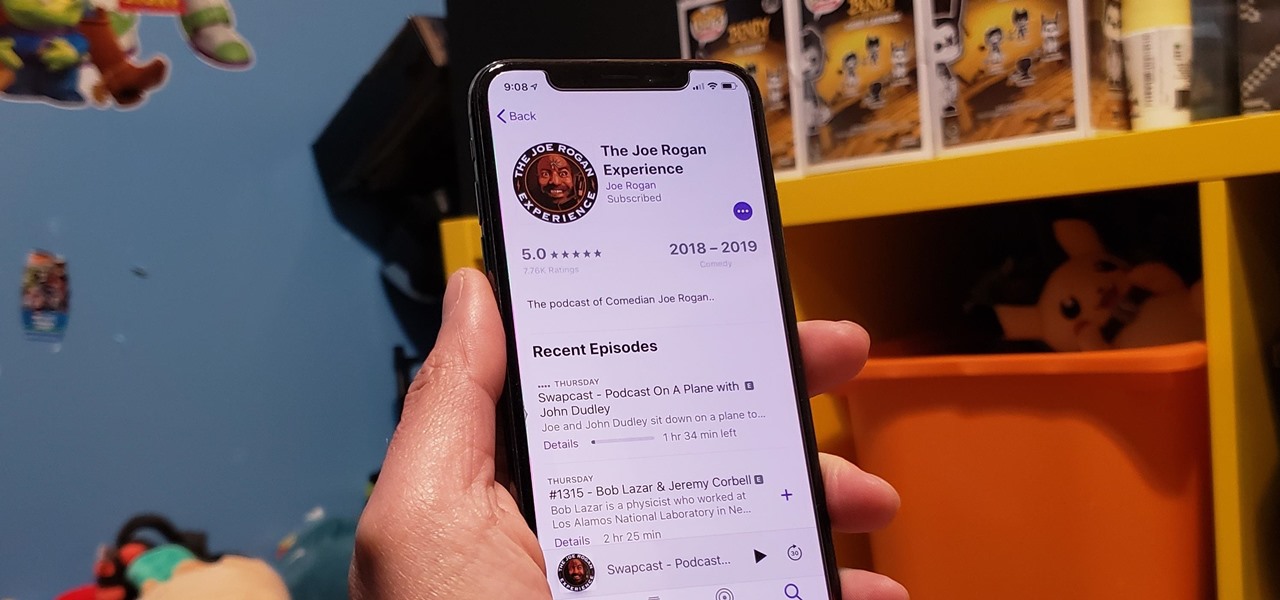Home>Events & Info>Podcast>How To Share Podcast


Podcast
How To Share Podcast
Modified: January 22, 2024
Learn how to easily share your podcast with our step-by-step guide. Increase your reach and engagement by leveraging the power of podcasting.
(Many of the links in this article redirect to a specific reviewed product. Your purchase of these products through affiliate links helps to generate commission for AudioLover.com, at no extra cost. Learn more)
Table of Contents
Introduction
Podcasting has become increasingly popular in recent years, with millions of people tuning in to listen to their favorite podcasts. Whether you’re a podcast host or a guest, one of the key goals is to maximize the reach of your podcast by sharing it with as many listeners as possible. In this article, we will explore various strategies to effectively share your podcast and increase its visibility.
Sharing your podcast is essential for attracting new listeners, building a loyal audience, and potentially monetizing your content. With the right approach and tools, you can reach a wider audience, grow your listener base, and establish your podcast as a must-listen show in your niche.
In this guide, we will walk you through the process of sharing your podcast, from choosing a podcast hosting platform to submitting your podcast to directories, and everything in between. We will also provide you with tips on collaborating with other podcasters and encouraging your listeners to share your episodes.
So, whether you’re a beginner podcaster looking to gain traction or an experienced host aiming to expand your podcast’s reach, let’s dive in and learn the best strategies for sharing your podcast effectively.
Choose a Podcast Hosting Platform
The first step in sharing your podcast is to choose a reliable and feature-rich podcast hosting platform. A podcast hosting platform is where you will upload your episodes, create an RSS feed, and manage your podcast’s distribution. When selecting a hosting platform, consider the following factors:
- Reliability: Look for a hosting platform that guarantees high uptime and fast loading speeds to ensure your podcast is accessible to listeners at all times.
- Storage and Bandwidth: Consider the amount of storage and monthly bandwidth provided by the hosting platform. Make sure it aligns with your podcasting needs, especially if you plan to release frequent episodes.
- Analytics: Choose a platform that offers robust analytics to track your podcast’s performance, such as the number of downloads, listener demographics, and popular episodes.
- Distribution: Ensure that the hosting platform distributes your podcast to popular directories like Apple Podcasts, Spotify, Google Podcasts, and Stitcher. This will ensure your podcast reaches a wider audience.
- Monetization Options: If you plan to monetize your podcast through sponsorships or advertising, look for a hosting platform that provides monetization features and integrates with advertising networks.
- Customization: Consider the platform’s ability to customize your podcast’s branding, including the show artwork, episode descriptions, and podcast player embed options.
Some popular podcast hosting platforms include Podbean, Libsyn, Anchor, and Buzzsprout. Take the time to research and compare different platforms to find the one that best suits your needs and budget.
Once you have chosen a podcast hosting platform, sign up for an account and familiarize yourself with its features. This will allow you to easily upload and manage your podcast episodes in the future.
Now that you have selected a hosting platform, it’s time to upload your podcast and prepare it for sharing with the world.
Upload Your Podcast
After choosing a podcast hosting platform, the next step is to upload your podcast episodes. Uploading your podcast involves adding your audio files and providing the necessary metadata to showcase your show effectively. Follow these steps to upload your podcast:
- Create an Account: If you haven’t already, sign up for an account on your chosen podcast hosting platform. This will grant you access to the necessary tools for uploading and managing your episodes.
- Prepare Your Audio Files: Before uploading, make sure your podcast episodes are properly edited, mixed, and saved as MP3 files. Be mindful of the audio quality and ensure that it is clear and enjoyable for your listeners.
- Add Episode Details: Enter the required information for each episode, such as the title, description, episode number, and any relevant tags or categories. This metadata helps listeners discover and understand your episodes better.
- Upload Your Audio Files: Use the podcast hosting platform’s interface or dashboard to upload your audio files. Depending on the platform, you may be able to upload multiple episodes at once or schedule future release dates.
- Set Episode Artwork: Upload a visually appealing image associated with each episode. This artwork will be displayed on podcast directories and platforms, so it should accurately represent the episode’s content and entice potential listeners.
- Add Show Notes: Include detailed show notes for each episode, summarizing the key discussion points, guest names, and any relevant links or resources mentioned during the show. Show notes provide additional context for your episodes and improve searchability.
- Preview and Publish: Take advantage of the hosting platform’s preview feature to review your episode before publishing it. Check for any errors, ensure proper audio playback, and verify that all the information is accurate. Once satisfied, hit the publish button to make your episode live.
Remember to follow your podcast hosting platform’s guidelines and recommendations for uploading episodes. Some platforms may have limitations on file size or format, so be sure to comply with those requirements.
With your episodes successfully uploaded, you’re now ready to move on to the next step: creating sharing links to promote your podcast.
Create Sharing Links
Creating sharing links for your podcast is an effective way to make it easy for your audience to share your episodes with their friends, family, and social media followers. Sharing links allow users to quickly share your podcast on various platforms, increasing its reach and potential for discovery. Here’s how you can create sharing links for your podcast:
- Podcast Directories: Most podcast hosting platforms offer the option to automatically generate sharing links for popular podcast directories like Apple Podcasts, Spotify, Google Podcasts, and more. These links can be added to your website or shared directly with your audience, encouraging them to subscribe and listen on their preferred platform.
- Social Media: Create individual sharing links for each of your podcast episodes and share them on social media platforms like Twitter, Facebook, and LinkedIn. Adding relevant hashtags, engaging descriptions, and eye-catching visuals can help attract more listeners and spark conversations.
- Email Newsletters: Include sharing links in your email newsletters to encourage your subscribers to forward the newsletter to others or share specific episode links. Make it easy for them to click and share with just a few taps or clicks.
- Website and Blog: Insert sharing buttons or icons on your podcast website and blog posts to enable visitors to share your episodes with their networks. These buttons can be programmed to generate pre-populated sharing messages or tweets for users to send with a single click.
- CTA banners: Create custom call-to-action (CTA) banners or graphics with sharing links embedded. Display these banners on your website, in your email signatures, or on social media profiles. Encouraging listeners to share your podcast with a clear and visually appealing CTA can significantly enhance your reach.
When generating sharing links, try to make them as user-friendly as possible. Use descriptive and concise language that entices users to click and share. Additionally, take advantage of URL shortening services like Bitly or Rebrandly to create shorter and more visually appealing links.
By providing sharing links, you empower your listeners to become promoters of your podcast and help you increase your audience base. The easier you make it for them to share your episodes, the more likely they are to do so.
Now that you have your sharing links ready, it’s time to effectively share your podcast on various social media platforms.
Share on Social Media
Social media platforms are powerful tools for promoting and sharing your podcast with a wide audience. With millions of active users on platforms like Twitter, Facebook, Instagram, and LinkedIn, social media provides a great opportunity to reach potential listeners and engage with your existing audience. Here are some strategies to effectively share your podcast on social media:
- Create Engaging Posts: Craft compelling and visually appealing social media posts that capture the essence of your podcast episodes. Use attention-grabbing headlines, quotes, or snippets from your episodes to entice users to listen. Incorporate eye-catching images or videos to increase click-through rates.
- Hashtags: Utilize relevant hashtags related to your podcast niche or topic to increase the discoverability of your posts. Research popular hashtags that your target audience follows and incorporate them strategically in your social media captions.
- Engage with Your Audience: Respond to comments, messages, and mentions on social media to build relationships with your followers. Encourage discussions, ask for feedback, and thank listeners for their support. Engaging with your audience helps foster a sense of community and encourages listeners to share your podcast with others.
- Collaborate with Influencers: Reach out to influencers or experts in your podcast’s niche and ask them to share your episodes. Collaborating with influencers can help expand your reach and gain credibility among their followers.
- Share Behind-the-Scenes Content: Give your audience a glimpse behind the scenes by sharing photos or videos of your podcast recording process, guest interviews, or interesting moments during your episodes. This helps humanize your podcast and builds a deeper connection with your audience.
- Host Live Q&A Sessions: Schedule live question-and-answer sessions on platforms like Instagram Live, Facebook Live, or Twitter Spaces. Invite your audience to ask questions about your podcast topics or engage in conversations related to your episodes. Live sessions offer a unique opportunity to interact directly with your listeners.
- Promote Episode Highlights: Create short teaser clips or highlight reels from your podcast episodes and share them on social media. Choose intriguing snippets that spark curiosity and leave your audience wanting more. Include a call-to-action to direct users to listen to the full episode.
Don’t limit yourself to just one social media platform. Experiment with different platforms and identify the ones that resonate most with your target audience. Each platform has its own unique features and audience demographics, so tailor your content accordingly.
Remember to maintain an active and consistent presence on social media. Regularly share updates about new episodes, engage in conversations with your audience, and share interesting content related to your podcast’s niche. Consistency and authenticity are key to building a loyal and engaged social media following.
Now that you know how to effectively share your podcast on social media, let’s move on to embedding your podcast on your website for additional visibility.
Embed on Your Website
Embedding your podcast on your website is an excellent way to make your episodes easily accessible to your website visitors and encourage them to listen. By incorporating a podcast player directly on your website, you provide a seamless listening experience and increase the chances of converting website visitors into loyal listeners. Here’s how you can embed your podcast on your website:
- Choose a Podcast Player: Select a podcast player that suits your website design and functionalities. Most podcast hosting platforms provide an embeddable player that you can customize to match your branding and easily integrate into your website.
- Customize the Player: Use the customization features available in your chosen podcast player to match its appearance with your website’s theme and layout. Customize the colors, sizes, and playback options to create a cohesive and visually appealing integration.
- Get the Embed Code: Once you have customized your podcast player, retrieve the embed code provided by your hosting platform. This code contains the necessary HTML and JavaScript to display the player on your website.
- Insert the Embed Code: Access your website’s HTML editor or content management system (CMS) and navigate to the page or section where you want to display your podcast player. Paste the embed code into the appropriate location within the HTML editor.
- Preview and Adjust: Save the changes and preview your website to ensure that the embedded player appears correctly. Test the player by playing an episode to ensure the audio is working properly.
- Consider Placement and Visibility: Strategically place the embedded podcast player on your website where it is easily visible and accessible to your visitors. Consider placing it on the homepage, sidebar, or dedicated podcast page to maximize engagement.
- Add Episode Descriptions: To provide context and entice visitors to listen, add brief descriptions or highlights of your episodes near the embedded player. This helps users understand what the podcast is about and encourages them to give it a listen.
- Make it Mobile Friendly: Ensure that the embedded podcast player is responsive and mobile-friendly, allowing users to easily listen to your episodes on their smartphones or tablets. Test the player’s functionality on various mobile devices to provide a seamless experience for your mobile audience.
Embedding your podcast on your website not only provides a convenient listening experience for your audience but also keeps them on your website for longer durations, increasing engagement and potential conversions.
Now that your podcast is embedded on your website, it’s time to submit your podcast to directories to expand your reach and attract new listeners.
Submit to Podcast Directories
To maximize the visibility of your podcast and attract a larger audience, it’s crucial to submit your podcast to various podcast directories. Podcast directories are platforms where users can search for and discover new podcasts based on their interests. Here are the steps to submit your podcast to directories:
- Apple Podcasts: As one of the most popular podcast directories, Apple Podcasts (formerly known as iTunes) is a must-submit platform. Create an Apple ID if you don’t have one, navigate to Apple Podcasts Connect, and follow the submission process. Provide all the necessary details about your podcast, including the RSS feed URL, artwork, and description.
- Spotify: Spotify has become a prominent platform for podcast listening. Visit the Spotify for Podcasters portal, sign in with your Spotify account, and submit your podcast using the provided submission form. Fill in details such as podcast name, description, category, and upload high-quality artwork.
- Google Podcasts: Submitting your podcast to Google Podcasts ensures that it integrates with Google’s search results and Google Assistant. Visit the Google Podcasts Manager, sign in with your Google account, and submit your podcast’s RSS feed. Provide accurate information about your podcast and ensure your artwork meets the specifications.
- Stitcher: Stitcher is another popular podcast directory that offers a wide range of podcasts to listeners. Submit your podcast by creating an account on Stitcher’s partner portal, selecting the “Add Shows” option, and entering your podcast’s information, including the RSS feed URL and artwork.
- Other Directories: In addition to the aforementioned directories, consider submitting your podcast to other platforms like TuneIn, iHeartRadio, Overcast, and Pocket Casts. Each platform may have its submission process and requirements, so review their guidelines and follow the instructions for optimal results.
While these directories are essential for gaining exposure, it’s important to note that the submission process may take some time. Allow a few days or even weeks for your podcast to appear on these platforms after submission.
Once your podcast is listed on various directories, regularly monitor and update your podcast profiles. Keep your show’s description and artwork up to date, and respond to listener reviews and feedback to maintain engagement with your audience.
Submitting your podcast to directories expands its reach and makes it easily discoverable by users searching for content in your genre or topic. Now, let’s explore the benefits of collaborating with other podcasters to amplify your podcast’s exposure.
Collaborate with Other Podcasters
Collaborating with other podcasters is a highly effective strategy for expanding your podcast’s reach, gaining new listeners, and building valuable connections within the podcasting community. Here are a few ways you can collaborate with other podcasters:
- Guest Appearances: Participate as a guest on other podcasts that have an audience aligned with your target demographic. This allows you to showcase your expertise, share your podcast with a new audience, and establish yourself as an authority in your niche.
- Host Joint Episodes: Collaborate with other podcasters to host joint episodes where you discuss a shared topic or interview a guest together. This introduces your podcast to their audience while providing a fresh and engaging episode for your own listeners.
- Cross-Promotion: Partner with other podcasters to cross-promote each other’s shows. This can be done through episode shout-outs, social media mentions, or including each other’s podcast links in show notes or newsletters. Cross-promotion exposes your podcast to new listeners who are already interested in similar content.
- Podcast Swaps: Arrange podcast swaps where you temporarily host another podcaster’s episode and they host yours. This allows both parties to tap into each other’s audience and gain exposure to a new set of listeners.
- Collaborative Marketing Projects: Collaborate with other podcasters on joint marketing initiatives, such as co-hosting a webinar, hosting a virtual summit, or launching a joint giveaway. These projects enable you to pool resources, reach a wider audience, and benefit from the combined promotional efforts.
- Interview Exchanges: Exchange interview opportunities with other podcasters. You interview them on your podcast, and they interview you on theirs. This exposes your podcast to their audience and vice versa, creating a mutually beneficial arrangement.
When reaching out to collaborate with other podcasters, be professional and provide value. Research their podcast to ensure that your offerings align with their audience’s interests. Personalize your outreach messages and clearly articulate the benefits of collaborating with you.
Collaborating with other podcasters not only helps you tap into new audiences but also strengthens your network within the podcasting community. Cultivating relationships with fellow podcasters can lead to future collaborations, cross-promotion opportunities, and the sharing of valuable insights and experiences.
Now that you understand the power of collaboration, let’s explore ways to encourage your listeners to share your podcast with their network.
Encourage Listeners to Share
Your listeners can be your biggest advocates when it comes to spreading the word about your podcast. Encouraging them to share your episodes with their network can significantly increase your podcast’s visibility and attract new listeners. Here are some effective strategies to encourage your listeners to share:
- Call-to-Action: Include a clear and compelling call-to-action at the end of each episode, urging your listeners to share the episode with their friends, family, or on social media. Make it easy for them to take action by providing specific instructions and sharing links.
- Word-of-Mouth Recommendations: Emphasize the power of personal recommendations. Encourage your listeners to share your podcast with their close circle and recommend it to others who might find it valuable. Remind them that their recommendations carry weight and can influence others to give your podcast a listen.
- Social Media Sharing: Prompt your listeners to share your episodes on their social media profiles. Add social sharing buttons on your podcast website or blog posts to make it convenient for them to share directly from the episode page. Consider offering incentives like shout-outs or exclusive content for listeners who share your episodes on social media.
- User-Generated Content: Encourage your listeners to create user-generated content related to your podcast. For example, ask them to share their favorite episode moments, insights, or fan artwork on social media and tag your podcast. This not only promotes their engagement but also generates social proof and boosts your podcast’s visibility.
- Engage with Listener Feedback: Pay attention to comments or messages from your listeners and respond to them. Acknowledge and appreciate their support, and encourage them to share their thoughts about the podcast publicly. Engaging with your listeners not only fosters loyalty but also encourages them to share their positive experiences with others.
- Exclusive Content for Sharing: Create bonus or exclusive content that you offer exclusively to listeners who share your podcast. This could be access to behind-the-scenes footage, additional episodes, or exclusive interviews. Encouraging sharing in exchange for valuable content incentivizes your listeners to spread the word.
- Contests and Giveaways: Run contests or giveaways where listeners can participate by sharing your podcast. For example, encourage them to share a specific episode on social media and tag your podcast to enter a drawing for a prize. This creates a sense of excitement and generates buzz around your podcast.
Consistently remind your listeners of the benefits they can gain by sharing your podcast, such as providing valuable content to others, being part of a supportive community, or helping others discover a podcast they enjoy. Show gratitude for their support and actively engage with the shared content to encourage further participation.
By actively seeking and appreciating your listeners’ contributions, you foster a community of dedicated supporters who will enthusiastically share your podcast with their networks.
Now that you have the strategies to encourage sharing, it’s time to wrap up and reinforce the importance of sharing your podcast to reach a wider audience.
Conclusion
Sharing your podcast is essential for growing your audience, increasing the visibility of your show, and establishing yourself as a notable presence in the podcasting landscape. By implementing the strategies outlined in this article, you can effectively share your podcast and attract new listeners.
Start by choosing a reliable podcast hosting platform that provides the necessary features for uploading and managing your episodes. Create sharing links that make it easy for your audience to share your podcast on various platforms. Leverage social media to promote your episodes, engage with your audience, and collaborate with other podcasters to expand your reach. Embed your podcast on your website to provide a seamless listening experience for your website visitors.
Don’t forget to submit your podcast to popular directories like Apple Podcasts, Spotify, and Google Podcasts to increase its discoverability. Collaborate with other podcasters to tap into new audiences and foster valuable connections within the podcasting community. Finally, encourage your listeners to share your podcast through clear calls-to-action, incentives, and user-generated content.
Remember, the success of your podcast relies not only on the quality of your content but also on your ability to effectively share it and engage with your audience. Stay consistent, provide value, and adapt your strategies based on the feedback and preferences of your listeners.
By implementing these strategies and constantly seeking new opportunities to share your podcast, you will gradually build a loyal listener base, expand your reach, and establish your podcast as a valuable resource in your niche.
So go ahead, take action, and start sharing your podcast with the world!











